
How to pair Callistemon?
Inspirations and tips to showcase Bottlebrushes
Contents
Approximately 25 species native to Australia and Tasmania make up the group of Bottlebrushes, evergreen bushes that naturally grow in dry terrain. These plants are part of the pyrophytes, meaning they are adapted to withstand fire. Their common name comes from their magical inflorescences shaped like brushes, showcasing a full range of reds and pinks. There are also a few varieties with white or yellow flowers. Best suited to mild climates, Callistemons can take the form of dwarf specimens suitable for pot cultivation, shrubs that enliven hedges, or small trees… providing numerous opportunities to incorporate them into hedges or borders, by the sea, or in Mediterranean or exotic arrangements. Whatever your desires, discover here how to create beautiful combinations with your callistemons!
Need more tips on growing Bottlebrushes? Feel free to check our guide “Callistemon, Bottlebrush: planting, pruning, care.”

The incomparable summer flowering of Bottlebrushes
In a seaside garden
Callistemon viminalis ‘Captain Cook’ is a stunning shrub or small tree reaching 2m with a trailing habit and evergreen foliage. It thrives effortlessly by the seaside, perfectly tolerating salty air and soils. It has a dense, naturally rounded habit and produces scarlet red flower spikes twice: in spring and then in early autumn. It joyfully enlivens coastal borders in mild climates or mixed hedges in seaside gardens alongside Ceanothus, known as California Lilac due to their lilac-purple flowering. For example, plant the variety Ceanothus thyrsiflorus ‘Repens’ in the foreground with its groundcover habit. Interspersed in this seaside display, the Mexican Oranges Choisya ‘Aztec Pearl’ with their pure white flowers and intoxicating scents are ideally suited to the location. Finally, you can easily complete the picture with the Japanese Spindle Euonymus japonicus ‘Bravo’ and its variegated yellow foliage, which is very bright.
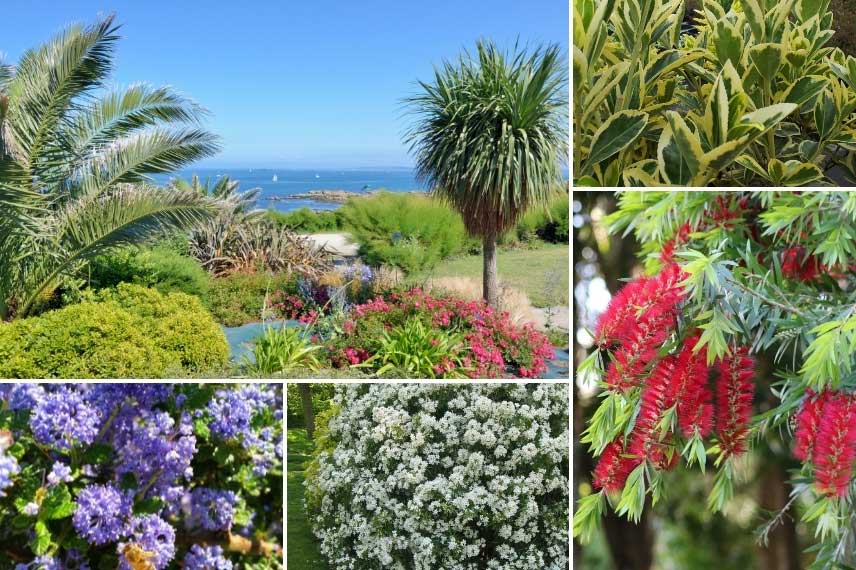
Clockwise: seaside atmosphere, Euonymus japonicus ‘Bravo’, Callistemon viminalis ‘Captain Cook’ in flower from May to June and from August to September, Choisya ‘Aztec Pearl’ and Ceanothus thyrsiflorus ‘Repens’ in flower in May-June
In a pot, on a terrace with bold colours
Take advantage of the bold and bright colours of the Bottlebrush to energise a terrace with a seating area in red and white! On this terrace with containers and pots, dare to use the Callistemon masotti ‘Mini Red‘, a superb dwarf variety suitable for pot cultivation. At maturity, it will barely exceed 1m. Its dense branches with small, leathery greyish leaves bear beautiful bright red inflorescences from March to May. This species is not very hardy (-5°C) and will complement the red and white tones of the pom-poms of the Dahlia balls ‘Cum Laude’, which bloom all summer until autumn. Additionally, fill your pots with the generous double Mini-petunias Calibrachoa Superbells ‘Double Ruby’ and Osteospermum ‘Summersmile Cream’, covered in small white daisies from June to October.

Clockwise: Basque atmosphere with Callistemon masotti ‘Mini Red‘ in bloom from March to May, Osteospermum ‘Summersmile Cream’ and Calibrachoa Superbells ‘Double Ruby’ in bloom from June to October and Dahlia ball ‘Cum Laude’ in bloom from July to October
Discover other Callistemon
View all →Available in 2 sizes
Available in 1 sizes
Available in 2 sizes
Available in 1 sizes
Available in 1 sizes
Available in 2 sizes
Available in 2 sizes
Available in 2 sizes
Available in 1 sizes
Available in 2 sizes
In a Mediterranean garden
Considered a Mediterranean climate plant, the Bottlebrush is well-suited to drought conditions. If you wish to include it in a low-maintenance landscape, such as a large rock garden or a dry garden with gravel, choose the Callistemon citrinus ‘Mauve Mist’, which stands out among other species with its mauve-pink brush-like flowers from June to August. This beautiful evergreen shrub with aromatic foliage will reach 2.5m in height and will pair beautifully intertwined with lovely olives. Accent with Yucca rostrata, featuring thick, short trunks topped with long blue-green leaves, and Yucca gloriosa. The species type has bright green foliage, while the variety ‘Variegata’ features cream-margined leaves. They will easily withstand negative temperatures down to -10°C and will be adorned with impressive clusters of fragrant white bell-shaped flowers from May to July. To complement the blooms, plant the magnificent and highly floriferous Polygala myrtifolia, with a bushy habit. Covered in violet-pink flowers that stand out against the soft green foliage for almost the entire year, it is also drought-resistant. The Agapanthus ‘Charlotte’, repeat flowering from June to September, will add vibrancy with its blue-violet umbels from June to September.
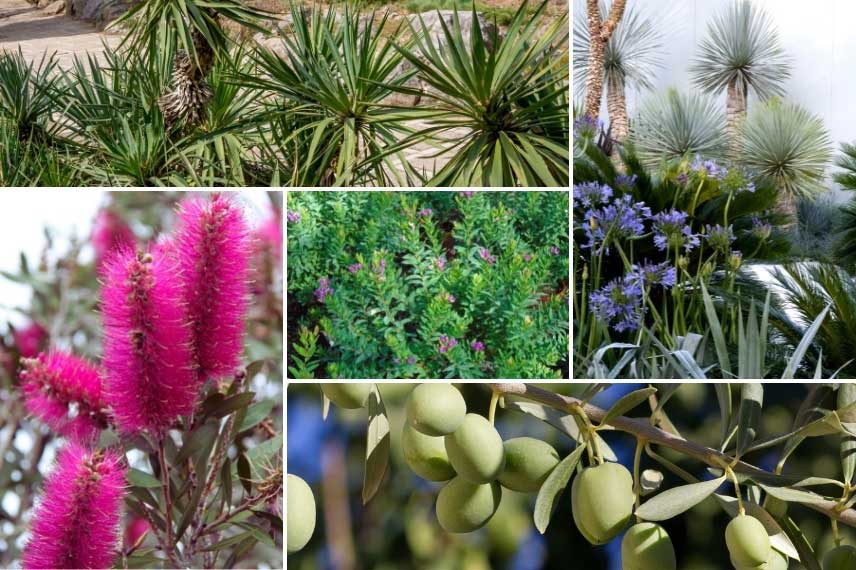
Clockwise: Yucca gloriosa, Yucca rostrata and flowering agapanthus, olive, Callistemon citrinus ‘Mauve Mist’ flowering from June to August. Centre: Polygala myrtifolia
In an exotic atmosphere
To create an exotic-looking garden corner, you can plant Callistemon viminalis: it is a beautiful small-growing tree, suitable for limited spaces. Its branches have a beautifully weeping habit and are covered in bright red bottlebrush flowers twice a year: from May to June and then in August-September. Its evergreen leaves are a lovely grey-green. The Chinese Windmill Palm Trachycarpus fortunei, suited to the most extreme conditions of drought as well as cold with a resistance to -18°C, will display its large palms alongside the Bottlebrush. Additionally, plant the Dasylirion cedrosanum. This tufted plant, reminiscent of yuccas in its architecture but with finer leaves, enhances the exotic look of the garden alongside the Cordyline indivisa, an evergreen plant that evokes the silhouette of palms.

Callistemon viminalis on the left. On the right from top to bottom: Trachycarpus fortunei, Dasylirion, and Cordyline indivisa
In an evergreen free hedge
The natural silhouette of the Bottlebrush makes it ideally suited for planting in a free hedge. To create a decorative evergreen hedge throughout the year, plant the Callistemon citrinus ‘Splendens’. It will flower from June to August and reach a maximum height of 2.5m and a spread of 2m. The Grevillea juniperina ‘Canberra Gem’ will kick off the flowering season from March to July. Its fine, short needle-like leaves lighten the appearance of the hedge, while its purple flowers add a unique touch. The Spanish Broom Spartium junceum brightens up spring with its sunny yellow flowers, while the Oleanders Nerium oleander mark the summer season. You can intersperse among these flowering shrubs the Pittosporum heterophyllum: just as evergreen and dense as the others, it boasts beautiful elegant foliage and delicate cream flowers in May-June. By respecting the appropriate spacing, your hedge will adopt a lovely free form without requiring pruning and will remain attractive throughout the seasons!

Grevillea juniperina ‘Canberra Gem’ in flower from March to July, Spartium junceum in flower in May-June, Callistemon citrinus ‘Splendens’ in flower from June to August, Pittosporum heterophyllum in flower in May-June, and Nerium oleander in flower all summer
Off to Australia!
Native to the Southern lands, the Bottlebrush sparks the imagination and invites you on a journey! For a layout that is both exotic and elegant, you can adopt – once is not customary – the white Callistemon citrinus ‘Albus’. Its slightly elongated brushes compared to those of other species and varieties, along with its somewhat spreading shrub habit, give it a bright and very aesthetic appearance. This is a low-growing variety, not exceeding 1m in height with a spread of 3m at maturity. It flowers from June to August, and its evergreen leaves release a pleasant lemony scent when crushed. The Australian Rosemary Westringia fruticosa complements the display with its lovely grey foliage and small white flowers from April to September alongside the Australian Mint Prostanthera cuneata. To enhance the colours, plant the Blue Hibiscus of Australia Alyogyne huegelii, hardy down to -5 °C in well-drained, dry soil in winter, with its incomparable mauve flowering extending from May to August.
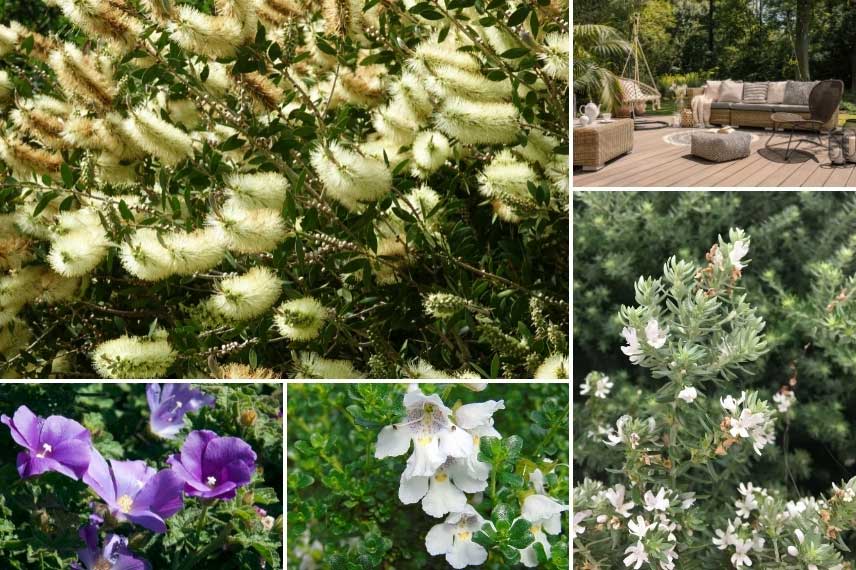 Clockwise: Callistemon citrinus ‘Albus’, evoking the Australian atmosphere, Westringia fruticosa, Prostanthera cuneata, and Alyogyne huegelii</caption]
Clockwise: Callistemon citrinus ‘Albus’, evoking the Australian atmosphere, Westringia fruticosa, Prostanthera cuneata, and Alyogyne huegelii</caption]
A candy pink greenery room for a little princess
Little princesses are not to be outdone thanks to the bright pink brushes of the Callistemon viminalis ‘Bright Pink’! Paired with the pink grasses Muhlenbergia capillaris, this beautiful shrub will bloom in May-June, with a repeat flowering in August-September. They can take their place in a garden area dedicated to children, to brighten up the surroundings of the essential playhouse! The cotton candy-like inflorescences of the dwarf smoke tree Cotinus ‘Smokey Joe’ will serve as a backdrop for the highly floriferous bush sage Salvia microphylla ‘Little Kiss’. And don’t forget the sweet-toothed: plant some raspberry plants that flower repeatedly!
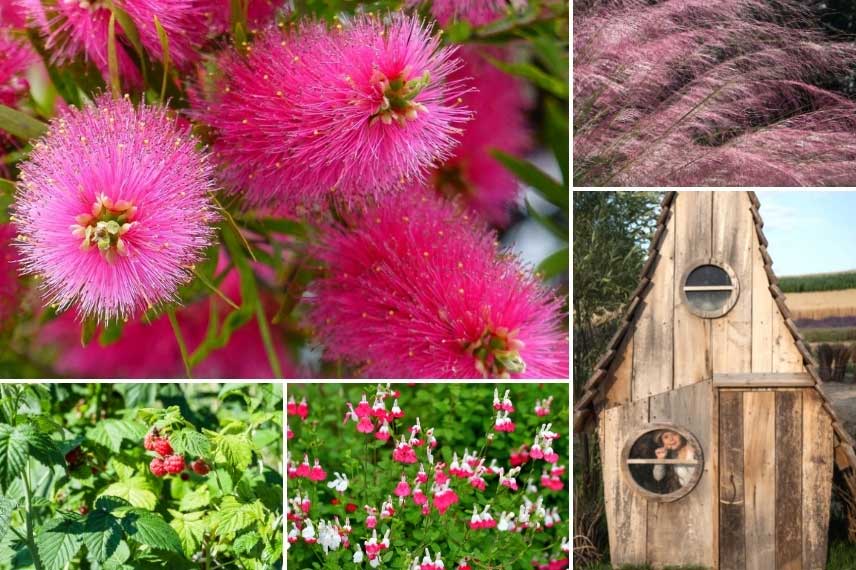
Clockwise: Callistemon viminalis ‘Bright Pink’, Muhlenbergia capillaris, wooden playhouse, Salvia microphylla ‘Little Kiss’ and raspberry plants
For further reading
- Discover our article: How to choose a Callistemon?
- Subscribe!
- Contents
![[plant1="Bottlebrush"] - [plant2="Companion planting"]](https://en.promessedefleurs.eu/blogwp/wp-content/uploads/2021/11/Callistemon-Associer-1.jpg)

































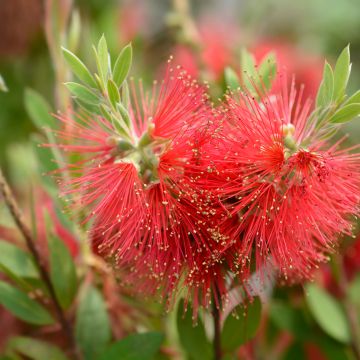
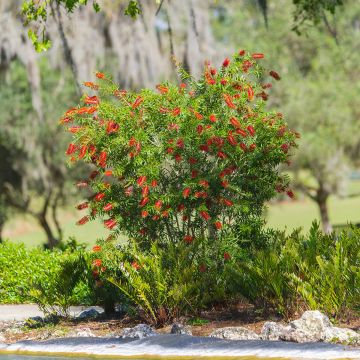
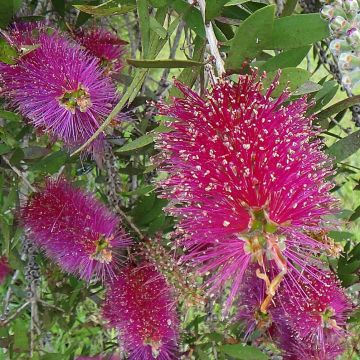
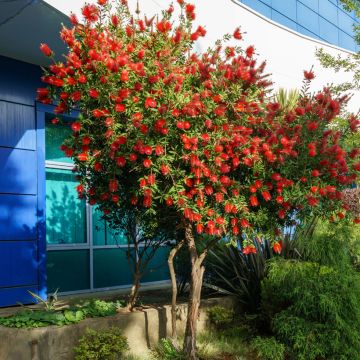
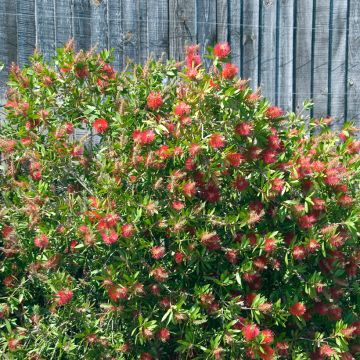
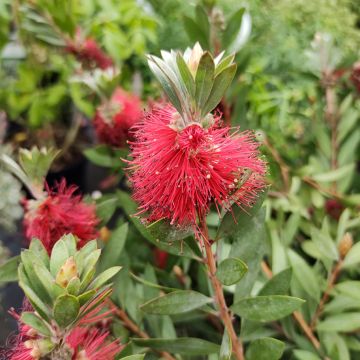
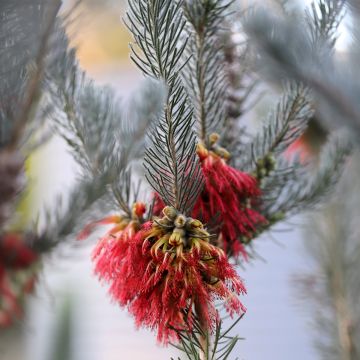

Comments